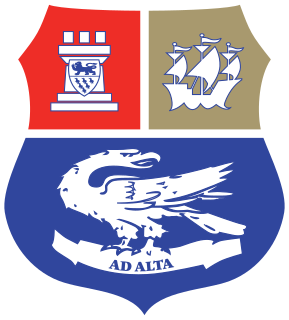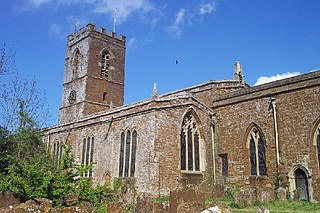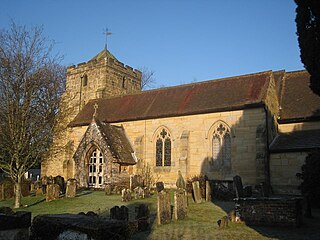
Accepted Frewen was a priest in the Church of England and Archbishop of York from 1660 to 1664.

Seaford College is an independent co-educational boarding and day school at East Lavington, south of Petworth, West Sussex, England. Founded in 1884, it is a member of the Headmasters' and Headmistresses' Conference. The college is in Lavington Park, a 400 acres (1.6 km2) Area of Outstanding Natural Beauty in the South Downs. The land is owned by a charitable trust and the site is run by the Board of Governors who are the trustees. The college is the inspiration for the Jennings and Darbishire children's books, written by alumnus Anthony Buckeridge.

Swalcliffe is a village and civil parish about 5 miles (8 km) west of Banbury in Oxfordshire. The parish is about 2+1⁄2 miles (4 km) long north–south and about 1 mile (1.6 km) east–west. The 2011 Census recorded the population of the modern Swalcliffe parish as 210. The toponym "Swalcliffe" comes from the Old English swealwe and clif, meaning a slope or cliff frequented by swallows. The ancient parish of Swalcliffe was larger than the present civil parish, and included the townships of Epwell, Shutford, Sibford Ferris and Sibford Gower.

Balcombe is a village and civil parish in the Mid Sussex District of West Sussex, England. It lies 31 miles (50 km) south of London, 16 miles (26 km) north of Brighton, and 32 miles (51 km) east north east of the county town of Chichester. Nearby towns include Crawley to the north west and Haywards Heath to the south south east.

East Sussex College or East Sussex College Group is the largest higher education college in East Sussex, providing education and training from foundation to degree level. The college educates almost half of the county's young people and over 8,000 adults each year at campuses in Lewes, Eastbourne, Hastings and Newhaven, and in the workplace.

Northiam is a village and civil parish in the Rother district, in East Sussex, England, 13 miles (21 km) north of Hastings in the valley of the River Rother. The A28 road to Canterbury and Hastings passes through it.

Sedlescombe is a village and civil parish in the Rother district of East Sussex, England. The village is on the B2244 road, about 6 miles (10 km) north of Hastings. The parish includes the hamlet of Kent Street, which is on the A21 road.

Stanmer Park is a large public park immediately to the west of the University of Sussex, and to the north-east of the city of Brighton in the county of East Sussex, England, UK. It is a Local Nature Reserve and English Heritage, under the National Heritage Act 1983, has registered the park on the Register of Parks and Gardens of Special Historic Interest in England at Grade II level.

There are 24 Grade I listed buildings in the city of Brighton and Hove, England. The city, on the English Channel coast approximately 52 miles (84 km) south of London, was formed as a unitary authority in 1997 by the merger of the neighbouring towns of Brighton and Hove. Queen Elizabeth II granted city status in 2000.
Admiral Sir John Byng Frewen GCB was Commander-in-Chief Naval Home Command.

Florence Aylward was an English composer known for ballads.
John Frewen-Turner, born John Frewen, was an English landowner and politician.
John Frewen (1558–1628) was an English Puritan divine.
Susan Parkinson is best known as an English potter and for her work with the Arts Dyslexia Trust.

Wiston House is a 16th-century Grade I listed building set in the South Downs National Park on the south coast of England, surrounded by over 6,000 acres (2,400 ha) of parkland in Wiston, West Sussex. It is the home of Wilton Park, an executive agency of the Foreign and Commonwealth Office.

Burton Park is a 19th-century country house in the civil parish of Duncton in West Sussex, and is situated 1/2 a mile to the east of the village of Duncton, within its own estate. It is a Grade I listed building, now converted into multiple occupation.

Wings Place, formerly Ditchling Garden Manor, also known as Anne of Cleves House, is a Grade I country house in Ditchling, East Sussex, England. It is a Tudor house, said to be one of the best examples in the country.

Uckfield Baptist Church is a Baptist congregation based in the town of Uckfield in East Sussex, England. Although services now take place in a school, the cause—founded in 1785 by seceders from the nearby Five Ash Down Independent Chapel—had its own chapel from 1789 until 2005, when the building closed and was sold for residential conversion. The "simple brick chapel" was rebuilt in 1874 and has been listed at Grade II for its architectural and historical importance.

The Church of St Margaret the Queen is a grade I listed building in Buxted Park, East Sussex, England. It is dedicated to Saint Margaret of Scotland, an 11th-century Scottish queen. The church dates from the 13th century, with additions in the 15th and 16th centuries and restored in 1858. In the present day, it is a middle-of-the-road Church of England church and part of the Parish of Buxted and Hadlow Down in the diocese of Chichester.














